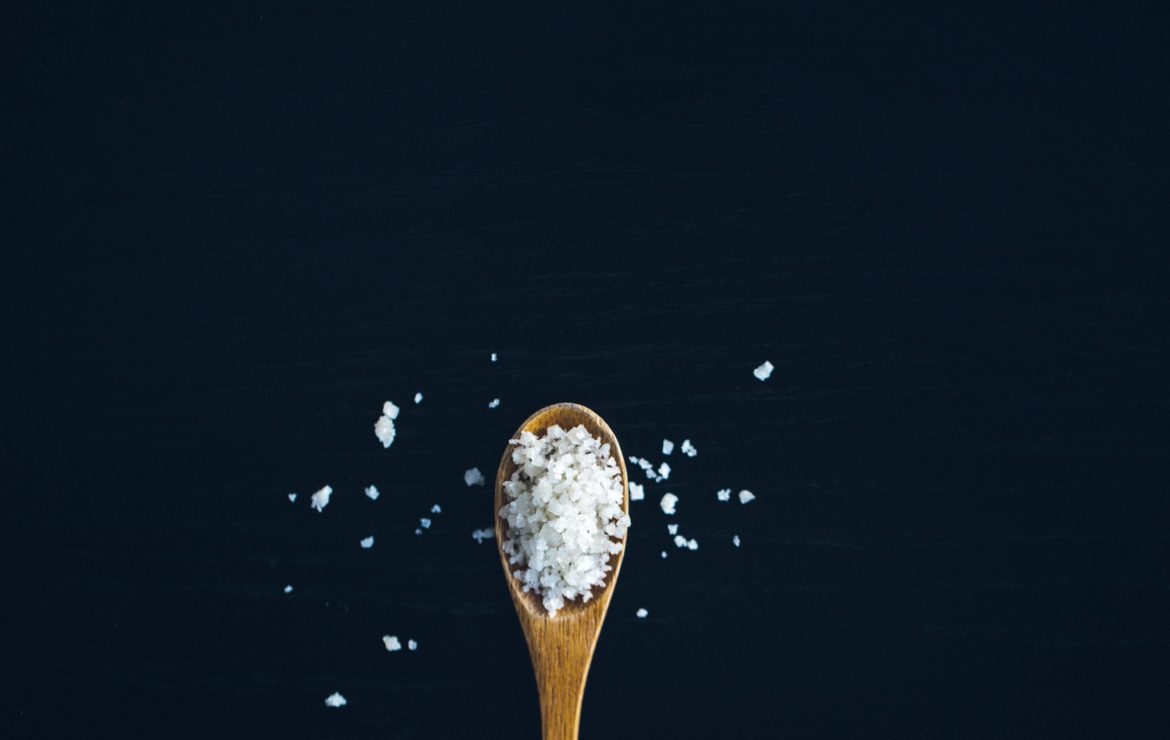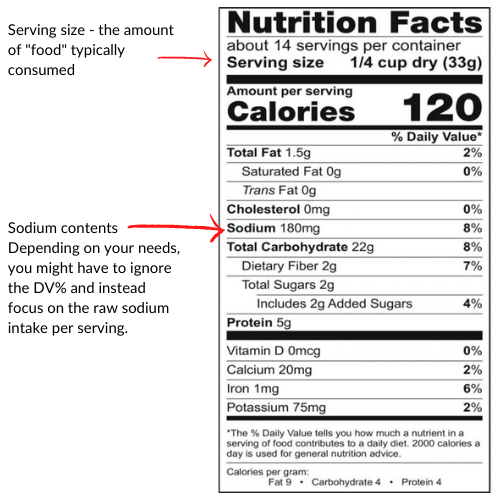Low Sodium Foods, Tips, and Guidelines

Sodium is a mineral & an electrolyte that helps regulate fluid balances in the body. The mineral is found naturally in foods, and as well as added to foods (salt). Our bodies only need a small amount of sodium to function properly, yet most Americans consume sodium at a surplus. Excess sodium can have adverse affects on health, from an increase in blood pressure, to making the body retain more fluids which may cause swelling in certain body parts such as the legs and feet. The daily recommendation is 2,300 mg per day, although, some individuals that can benefit from a low sodium diet are advised to consume lower amounts.
Reasons to consume a low sodium diet
Whether you are prescribed a low sodium diet by your dietician/healthcare provider, or if you are concerned about the health repercussions of consuming excess sodium, consuming less sodium may not only provide positive health benefits, but also prevent certain illnesses in the future.
Benefits of a low sodium diet:
- Help Prevent Heart Disease & aid in recovery (leading cause of deaths in the U.S.)
- Help Prevent Stroke & aid in recovery
- Reduces negative symptoms of Diabetes and Cirrhosis
- Help prevent brain damage caused from high blood pressure
- Lower your blood pressure
- Reduce your risk of a heart attack
- Lower your LDL cholesterol
- Prevent congestive heart failure
- Decrease your risk of kidney damage
- Prevent your chance of stroke
- Lessen the chance of a brain aneurysm
- Protect your vision
- Reduce your risk of diabetes
- Improve your memory
General guidelines for a low sodium diet
Do’s:
- Reduce the amount of salt you add to foods/when cooking
- Choose low sodium foods (how to read food labels)
- Salt substitutes are sometimes made from potassium, so read the label. If you are on a low potassium diet, then check with your doctor before using those salt substitutes.
- Season your foods with low sodium spices, herbs, lemon, garlic, ginger, vinegar and pepper
- Read ingredient labels to identify foods high in sodium (how to read food labels)
- Eat more home-cooked meals
- Avoid medications which contain sodium such as Alka Seltzer and Bromo Seltzer (consult your physician about the medication you take)
Dont’s:
- Don’t use seasoning & sauces that contain high levels of sodium – garlic salt, onion salt, meat tenderizers, broth mixes, soy sauce, teriyaki sauce, barbeque sauce, olives, pickles, bacon bits and more
- Don’t use softened water for cooking and drinking
- Don’t consume too much fast-foods (depending on your sodium target, you might want to avoid fast-foods at all)
- Don’t consume too many processed foods such as salted potato chips
- Don’t consume too many canned soups, entrees, instant cereal and puddings and sauce mixes
- Don’t use table salt substitutes unless otherwise
- Don’t drink liquids high in sodium like sports drinks, vegetable juices and caffeinated drinks
How to read nutrition labels for sodium
Understanding how to read nutrition labels is crucial when managing a low sodium diet. Use the Nutrition Facts section to check the amount of sodium in the foods you eat (or about to eat) and compare your options wisely. As a general rule of thumb, choose products with 5% Daily Value (DV) or less – a 20% of DV is considered too high, for example. Also, look for foods labeled “low sodium” or “reduced sodium” or “no salt added” as these varieties typically contain very little levels of sodium.
Sodium-related terms you could run into when checking nutrition labels:
- Sodium-free – Less than 5 milligrams of sodium per serving and contains no sodium chloride
- Very low sodium – 35 milligrams or less per serving
- Low sodium – 140 milligrams or less per serving
- Reduced (or less) sodium – At least 25 percent less sodium per serving than the usual sodium level
- Light (for sodium-reduced products) – If the food is “low calorie” and “low fat” and sodium is reduced by at least 50 percent per serving
- Light in sodium – If sodium is reduced by at least 50 percent per serving
Note: Sodium levels may vary in similar foods depending on brand & serving sizes.
For example, here is the Nutrition Facts of an ordinary breakfast cereal muffin. The two most important pieces of information we have to look out for when following a low sodium diet is the Serving Size, the amount of the “food” (in our case, the muffin) that is typically consumed, and as well as the Sodium, the amount of sodium contain in the “food” (muffin) per serving.

Find exact sodium contents using a food calculator
Use the build-in calculator from Webmd to find the exact sodium contents of the foods you eat.
- Open Webmd’s Food Calculator tool
- In the search bar, type the name of the food (e.g. “apple”, “rice”, “oatmeal”, “muffin”)
- Refine your search by selecting the type of food, serving size, and more
- Enter the serving size (refer to the Nutrition Facts of the food)
- After confirming your serving size, click on the “View Nutrition Facts” to see more macro nutrient information such as sodium levels, carbohydrates and more
Low sodium foods list
Sodium is a mineral & an electrolyte that helps regulate fluid balances in the body. The mineral is found naturally in foods, and as well as added to foods (salt). Our bodies only need a small amount of sodium to function properly, yet most Americans consume sodium at a surplus. Excess sodium can have adverse affects on health, from an increase in blood pressure, to making the body retain more fluids which may cause swelling in certain body parts such as the legs and feet. The daily recommendation is 2,300 mg per day, although, some individuals that can benefit from a low sodium diet are advised to consume lower amounts.
Vegetables and fruits
Low sodium – contains less than 140 mg of sodium
- Artichoke
- Bell pepper
- Broccoli
- Carrot
- Celery
- Radish
- Sweet Potato
Very low sodium – contains less than 35 mg of sodium
- Apricots, Dried
- Brussels Sprouts
- Cabbage, Green
- Cabbage, Pe-tsai
- Cabbage, Red
- Cantaloupe
- Cauliflower
- Cauliflower, Green
- Chickpeas
- Chili Peppers, Hot
- Collard Greens
- Endive
- Figs, Dried
- Grapes
- Honeydew
- Mushrooms
- Okra Onion
- Onion, Green
- Papaya
- Parsley
- Lentils
- Lettuce, Iceberg
- Lettuce, Leaf
- Lima Beans
- Peas, Split
- Pigeon Peas
- Pineapple
- Pink Beans
- Pinto Beans
- Prickly Pear
- Raisins, Seedless
- Rhubarb
- Rutabagas
- Snap Beans, Yellow
- Spaghetti Squash
- Tomato
- Small White Beans
- White Beans
- Winged Beans
No sodium – contains less than 5 mg of sodium
- Apple
- Apricot
- Asparagus
- Avocado
- Banana
- Green Beans
- Blackberries
- Blueberries
- Carambola
- Cherries, Sweet
- Corn
- Cucumber
- Currants, Dried
- Dates
- Eggplant
- Raspberries
- Squash, Crookneck
- Squash, Summer
- Strawberries
- Tangerine
- Watermelon
- Endive, Belgian
- Figs
- Garlic
- Gooseberries
- Grapefruit
- Guava Kiwifruit
- Lemon
- Lettuce, Romaine
- Lime
- Mango
- Nectarine
- Orange
- Peach
- Pear
- Pepper, Le Rouge Royale
- Plums
- Plums, Dried
- Potato
- Pummelo
Grains, breads and cereals
Grains and wheat-derived products usually contain high levels of sodium, so make sure to look for foods with 5% Daily Value (DV) or less for sodium – 20% or more is high.
- Whole grain bread
- Granola
- Puffed rice
- Rolled oats
- Shredded wheats
- Whole grains like brown or wild rice, barley or quinoa
- Whole-wheat or whole-grain pasta
- Whole-grain hot or cold breakfast cereals like oatmeal or shredded wheat
- Unsalted popcorn or low-sodium chips and pretzels
- Whole-grain breads, bagels, English muffins, tortillas, and crackers
Protein
Meat and poultry: Choose fresh cuts when possible. Avoid processed meats such as bacon, hot dogs, sausages and bologna.
- Beef
- Chicken
- Turkey
- Venison
- Lamb
- Pork
Seafood: Processed seafood may have higher sodium due to added salt.
- Catfish
- Tilapia
- Salmon
Soy: Soybeans are almost sodium free, making it one of the healthiest sources of protein on this list.
- Tofu
- Roasted soybeans
- Falafel
Dairy
Sodium contents in dairy products vary drastically depending on brand. Make sure to read the nutrition label in the back.
- Low sodium cottage cheese
- Fat free or low fat yogurt
- Skim or 1% milk
- Soy-based drinks with added
calcium - Cream
- Non-dairy creamers
- Sour cream
- Ice cream
Condiments & fats
Perfect for salad seasoning and to add a hint of flavor to foods.
- Unsalted nuts & seeds like peanuts, cashews, almonds, Brazilian nuts and pecans
- Olive oil and other cooking oils
- Low sodium mayonnaise
- Unsalted butter or margarine
- Low sodium salad dressings
- Spices and herbs without sodium
or salt - Vinegar
- Lemon
- Fresh horseradish or prepared
without salt - Baking soda and powder
- Cream of tartar
- Mustard
- Tabasco sauce or low sodium chili
sauces
Popular foods high in sodium you should avoid
Generally speaking, if you are on a low sodium diet, the list of foods you shouldn’t eat can be a lengthy one. Here are some examples of what you should avoid next time you are shopping:
- Bread and baked goods – Bagels, breakfast cereals, boxed mixes like cakes, pancakes, muffins, cornbread, baguettes
- Light snacks – Branded crackers and similar items like chips, pretzels, popcorn and ready dips
- Starchy carbohydrates – Mac and cheese mixes and other spaghetti mixes, instant, frozen and canned dishes, seasoned meals
- Canned fruits & veggies – Pickled vegetables, relishes, sauerkraut, tomato and any other sauces
- Legumes – Canned beans and peas, and packaged meals made with high sodium foods like bacon, pork and ham
- Meats – anything salted, canned or smoked; includes many deli meats and poultry, and the usual suspects are: hot dogs, sausages, salami, packaged beef jerky, frozen meat
- Drinks – Sports drinks, vegetable juices, some caffeinated drinks
- Dairy – Cottage cheese, buttermilk, and processed dairy like cheeses
- Other – Instant pudding, packaged desserts, powdered and canned soup mixes, stocks, frozen soups
Tips when following a low sodium diet
Reducing the amount of sodium you consume on a daily basis doesn’t have to be a compromise. You can still enjoy eating healthy foods that taste great even without the added salt. Here are several tips to help you make that transition:
- Add more potassium to your diet: Foods high in potassium can help lower your blood pressure. Good sources of potassium include sweet potatoes, cantaloupe, beans, bananas, milk and yogurt
- Choose less salt when eating out: If you are at a restaurant or a dining place, ask for low-sodium dishes, and let your waiter/waitress know that you want to avoid added salt as much as possible, they will let the chef/cook know when they’re preparing your food
- Cook more at home: Cooking at home is one of the best ways to ensure that the food you eat is exactly as you expect it to be. Avoid sodium rich seasoning and sauces, instead, replace with condiments like olive and coconut oils, and sauces that are low in sodium.
- Stay hydrated: Drink at least 8 glasses of water per day or as instructed by your healthcare provider





